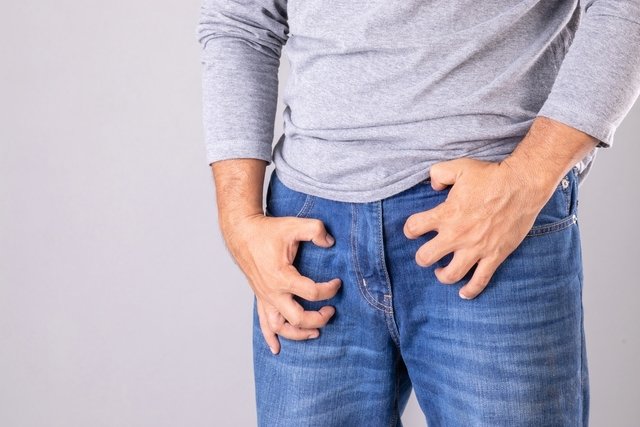Jock itch is a type of fungal infection that affects warm and moist skin, mainly in the groin and pubic area. It is associated with a red rash that is very itchy and may lead to the appearance of blisters in the area.
This fungal infection is also referred to as tinea cruris. It occurs in people who may wear overly hot clothing, who do not maintain adequate hygiene or who sweat profusely in the groin area. It is most commonly seen in men.
If you notice any signs of symptoms indicative of jock itch, you should see your family doctor or dermatologist for treatment, which usually involves the use of antifungal ointments.

Main symptoms
Jock itch is characterized by the appearance of a red rash in the groin area. It can happen on just one side or both and can even reach the pubic area in some cases. Other symptoms and characteristics of a jock itch rash are:
- Red rash with well-defined borders
- Rashes that grow outward, toward the extremities
- Rashes with raised borders
- Local itching
- The presence of blisters in some cases
In addition, it is common to experience a secondary infection by a bacteria or another fungus at the same time. Therefore, you should see your family doctor or a dermatologist as soon as you notice symptoms of jock itch, so that treatment can be started promptly and symptoms can be relieved.
Learn more about yeast infection symptoms in men.
Common causes
Jock itch is usually caused by Trichophyton rubrum and Trichophyton mentagrophytes fungi, howevver, it is possible for infections to emerge due to Epidermophyton or Microsporum species of fungus. These fungi are naturally found on the skin, but due to certain factors, they overgrow and feed on the keratin, causing symptoms.
Some factors that may increase the risk of jock itch are excessive sweating, overly hot clothing, inadequate hygiene, diabetes, and a weakened immune system. All of these can contribute to a favorable environment for fungal cells to grow.
Confirming a diagnosis
In most cases of jock itch, the diagnosis is confirmed by a doctor or dermatologist through inspection of the rash and an evaluation of the patient’s health history and habits. In some cases, the doctor may order additional testing to confirm the presence of Tinea cruris or rule out other skin problems with similar symptoms, like psoriasis, erythrasma, seborrheic dermatitis, and inguinal candidiasis.
The doctor may opt to send a fungal scraping of the rash for analysis under the microscope. With this test, lab technicians are able to identify the fungal cells that are causing symptoms.
Treatment options
Treatment for jock itch involves the use of oral or topical antifungals, like miconazole, clotrimazole, terbinafine, sulconazole, ketoconazole or itraconzole. These antifungals are used for 1 to 3 weeks as directed by the doctor, depending on the severity of the rash.
In addition, it is important to keep the area clean and dry, and to avoid clothing that is too hot or too tight. This can help to reduce the risk of re-growing fungal cells or other skin conditions.
Diet can also play a role in the treatment of fungal infections. Learn more about home remedies and foods to eat when treating a fungal infection.
